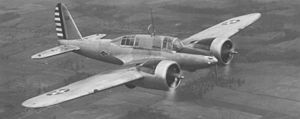- Curtiss A-18 Shrike
-
A-18 Shrike II Curtiss A-18 No. 52 assigned to Wright Field (Y1A-18, probably during testing). (U.S. Air Force photo) Role Ground-attack aircraft Manufacturer Curtiss Aeroplane and Motor Company First flight September 1935 (A-14) Retired 1940 Status Service test Primary user United States Army Air Corps Number built 13[1] Unit cost $105,000 [2] Developed from Curtiss YA-14 The Curtiss A-18 Model 76A Shrike II was a 1930s United States twin-engine ground-attack aircraft. It was the production test version of that company's XA-14.
Contents
Design and development
In the years leading up to World War II, the United States Army Air Corps were interested in attack aircraft capable of carrying larger bomb loads with greater firepower. The attack aircraft design standard essentially became a light bomber with firepower only slightly less than the medium bombers being developed as the standard .30 in (7.62 mm) machine gun generally was replaced by .50 in (12.7 mm) ones on new aircraft in development.[2]
The Curtiss YA-14 prototype that emerged in 1935 was one of the first single-mission attack aircraft. Although it looked purposeful with its slender fuselage, thin nose and sleek streamlining, the A-14 was hampered by a lack of power, despite its two 775 hp (578 kW) Wright Whirlwind radial engines. Nevertheless, the prototype was able to achieve a maximum speed of 254 mph (409 km/h), outstripping the frontline Boeing P-26 fighter by 20 mph (32 km/h).[2]Re-engined with 735 hp (548 kW) Curtiss R-1670-5 engines, it was delivered to the Army under serial number 36-146.[3]
Operational history
A newly improved variant, the Y1A-18 had upgraded 850 hp (630 kW) Wright R-1820-47 radial engines with three-blade propellers replacing the original two-blade models. Thirteen aircraft were produced, serial numbers 37-52 through 37-64,[3]and although successful in testing, further production was not ordered due to a lack of funds and the availability of more advanced aircraft (such as the A-20 Havoc) under design. After completion of service testing, the Y1A-18s were assigned to operational attack groups and redesignated A-18. The aircraft were initially sent to the 8th Attack Squadron, 3rd Attack Group at Barksdale Field, Louisiana. They won a USAAC award for bombing and gunnery in their first year of service.[4] The A-18 was only used for a short time before being replaced by more advanced attack aircraft. The A-18 was retired from front line service in 1940 and was never used in combat. The last A-18 in flying condition was grounded in 1943.[5]
Operators
Specifications (Y1A-18)
Data from The Complete Encyclopedia of World Aircraft[5]
General characteristics
- Crew: 2
- Length: 41 ft 0 in (12.50 m)
- Wingspan: 59 ft 6 in (18.14 m)
- Height: 11 ft 6 in (3.51 m)
- Wing area: 526 ft² (48.87 m²)
- Empty weight: 9,410 lb (4,268 kg)
- Max takeoff weight: 13,170 lb (5,974 kg)
- Powerplant: 2 × Wright R-1820-47 air-cooled radial engines, 850 hp (634 kW) each
Performance
- Maximum speed: 247 mph (398 km/h)
- Cruise speed: 217 mph (349 km/h)
- Range: 651 mi (1,048 km)
- Service ceiling: 25,650 ft (8,370 m)
Armament
- 4 × forward-firing .30 in (7.62 mm) M1919 Browning machine guns
- 1 × aft-firing .30 in (7.62 mm) machine gun
- 400 lb (272 kg) bombs in two wing bays
- 200 lb (91 kg) bombs or chemical smoke tanks underwing
See also
- Related development
- Aircraft of comparable role, configuration and era
- Related lists
References
Notes
- ^ Fahey, James C. U.S. Army Aircraft 1908-1946. New York: Ships and Aircraft, 1946.
- ^ a b c McCullough, Anson. "Grind 'Em Out Ground Attack: The Search for the Elusive Fighter Bomber." Wings, Vol. 25, No. 4, August 1995.
- ^ a b Swanborough, F. G. and Peter M. Bowers. United States Military Aircraft Since 1909. New York: Putnam, 1964. ISBN 0-85177-816-X.
- ^ Fitzsimons, Bernard, ed. "Vol. 21." The Illustrated Encyclopedia of the 20th Century Weapons and Warfare. London: Purnell & Sons Ltd., 1967/1969. ISBN 0839361750.
- ^ a b Eden and Moeng 2002, p. 517.
Bibliography
- Eden, Paul and Soph Moeng, eds. The Complete Encyclopedia of World Aircraft. London: Amber Books Ltd., 2002, ISBN 0-7607-3432-1.
- Swanborough, F. G. and Peter M. Bowers. United States Military Aircraft Since 1909. New York: Putnam, 1964. ISBN 0-85177-816-X.
External links
Lists relating to aviation General Aircraft (manufacturers) · Aircraft engines (manufacturers) · Airlines (defunct) · Airports · Civil authorities · Museums · Registration prefixes · Rotorcraft (manufacturers) · TimelineMilitary Accidents/incidents Records USAAS/USAAC/USAAF/USAF attack aircraft designations 1924–1962 (A-1 not assigned) • XA-2 • A-3 • A-4 • A-5 • A-6 • XA-7 • A-8 • XA-9 • YA-10 • XA-11 • A-12 • YA-13 • YA-14 • XA-15 • XA-16 • A-17 • A-18 • A-19 • A-20 • XA-21 • A-22 • A-23 • A-24 • A-25 • A-26 • A-27 • A-28 • A-29 • A-30 • A-31 • XA-32 • A-33 • A-34 • A-35 • A-36 • XA-37 • XA-38 • XA-39 • A-40 • XA-41 • XA-42 • XA-43 • XA-44 • XA-45
Categories:- Curtiss aircraft
- United States attack aircraft 1930–1939
- Twin-engined aircraft
Wikimedia Foundation. 2010.

